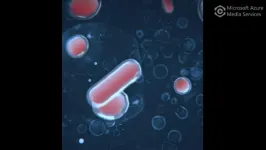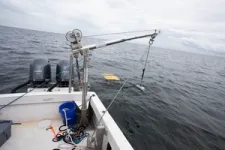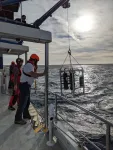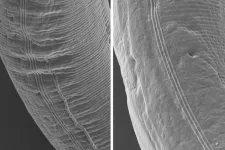(Press-News.org) Insilico Medicine (“Insilico”), a clinical-stage generative artificial intelligence (AI)-driven drug discovery company, today announced that four abstracts have been accepted as poster presentations at the American Association for Cancer Research (AACR) Annual Meeting 2023.
Insilico will present four novel inhibitors for the treatment of cancer developed with its end-to-end Pharma.AI platform. Drawing from trillions of data points and millions of compounds and molecular fragments, the platform uses generative AI for target identification and generative chemistry to produce new molecules.
“Our oncology pipeline is growing rapidly thanks to the capabilities of our generative AI platform,” says Sujata Rao, MD, Senior VP of Clinical Development at Insilico Medicine, who will present data on the Company’s anti-cancer assets. “We’ve been able to rapidly produce and advance a number of promising potentially first-in-class and best-in-class molecules that we hope can soon bring new therapeutic options to cancer patients who are not responding to other treatments.”
Michelle Chen, PhD, Insilico Medicine’s Chief Business Officer, will also attend AACR to discuss partnering and licensing opportunities. “We are actively looking for licensing partners for multiple assets in our pipeline who can work with us to further develop these drug candidates and help cancer patients,” says Dr. Chen.
Insilico has a robust pipeline of assets in the cancer space, among other disease areas, and will showcase four programs available for partnering and out-licensing at AACR. These include:
Abstract Title: ISM3091, a novel selective USP1 inhibitor as a targeted anticancer therapy
Session category: Experimental and molecular therapeutics
Session title: Novel antitumor agents 2
Session date & time: April 16, 1:30-5pm
Published abstract number: 502
Description: ISM3091 is an orally available and selective small molecule inhibitor of USP1, and demonstrated potential when targeted against a broad range of tumor lineages with HRD backgrounds. In vitro data showed potent anti-proliferation activity of the compound in BRCA-mutant tumor cells with excellent selectivity.
Abstract Title: ISM3412, a novel and selective MAT2A inhibitor for the treatment of cancer
Session category: Experimental and molecular therapeutics
Session title: Novel antitumor agents 2
Session date & time: April 16, 1:30-5pm
Published abstract number: 503
Description: MAT2A is defined as a synthetic lethality target in MTAP-deleted cancers and plays an essential role in producing S-adenosylmethionine (SAM), a molecule involved in cell function and survival. As a potent and selective MAT2A inhibitor, ISM3412 demonstrated excellent drug-likeness with good solubility and permeability, good activity at low doses in animal models, and a favorable safety profile in preclinical studies.
Abstract Title: Targeting DGKA for immuno-oncology therapy: ISM4312A, a novel DGKA inhibitor with robust anti-tumor activity
Session category: Immunology
Session title: Immunomodulatory agents and interventions 2
Session date & time: April 17, 9am-12:30pm
Published abstract number: 1855
Description: Research indicates that DGKA mediates T-cell dysfunction during anti-PD-1 therapy, playing a role in the development of resistance to PD-1 blockade. ISM4312A is a novel DGKA inhibitor with excellent potency and high selectivity in cancer immunotherapy. The compound enhanced T-cell activity in vitro and showed robust anti-tumor activities with or without anti-PD-1 therapy in vivo. Those data support the further evaluation of ISM4312A as a potential first-in-class DGKA inhibitor both as a single agent and in combination with a checkpoint inhibitor.
Abstract Title: Discovery and evaluation of ISM6466A, a novel covalent CDK12 inhibitor for the treatment of cancer
Session category: Experimental and molecular therapeutics
Session title: Targeting protein kinases and phosphatases for therapy 1
Session date & time: April 18, 1:30-5pm
Published abstract number: 4989
Description: CDK12 inhibitors work synergistically with chemotherapy and PARP inhibitors and can be effective in a number of cancer types, including triple negative breast cancer, colorectal cancer, ovarian cancer, and hepatocellular carcinoma. Insilico’s novel inhibitor, designed by its Pharma.AI platform, capitalizes on this cancer treatment approach that relies on the induction of the “BRCAness” phenotype.
Insilico has rapidly developed its portfolio with nearly 30 assets in a variety of disease areas, including a number in the oncology space. The Company has partnered with leading pharma companies including Sanofi and Fosun Pharma to develop their programs and is actively seeking partners for its available assets.
“Leveraging AI with support from our CROs and our dedicated and experienced drug discovery team, we have been able to deliver many high-quality drug candidates,” says Insilico Medicine founder and CEO Alex Zhavoronkov, PhD. “In addition, our AI-powered robotics laboratory has the potential to take drug discovery to the next level by combining images with high content, high throughput screenings with AI to deliver the medicines of the future.”
About Insilico Medicine
Insilico Medicine, a clinical stage end-to-end generative artificial intelligence (AI)-driven drug discovery company, is connecting biology, chemistry, and clinical trials analysis using next-generation AI systems. The company has developed AI platforms that utilize deep generative models, reinforcement learning, transformers, and other modern machine learning techniques for novel target discovery and the generation of novel molecular structures with desired properties. Insilico Medicine is developing breakthrough solutions to discover and develop innovative drugs for cancer, fibrosis, immunity, central nervous system diseases, infectious diseases, autoimmune diseases, and aging-related diseases. www.insilico.com
END
Red tides, caused by Karenia brevis blooms, are a recurring problem in the coastal Gulf of Mexico. The organism, Karenia brevis, produces toxins that can cause fish kills, respiratory irritation in humans and cause death in sea turtles, dolphins, manatees and birds.
The ability to detect red tide blooms at all life stages and cell concentrations is critical to increasing predictive capabilities and developing potential mitigation strategies to protect public health and vital resources.
Current methods used to monitor red tide such as microscopic identification and enumeration, standard flow cytometry, as well as others have limitations. Some of these ...
April 4, 2023, TORONTO — Becoming the first genomics lab to be accredited by three of the leading North American accreditation organizations positions OICR Genomics to generate new discoveries about what drives diseases like cancer and new, personalized ways to diagnose and treat them.
The lab earned a Clinical Laboratory Improvement Amendments (CLIA) certificate of accreditation in January 2023 for its whole genome and whole transcriptome sequencing assay, a comprehensive genetic test that can find all changes in the DNA of a tumour. This comes after accreditation from the College of American Pathologists (CAP) in 2021 and from Accreditation Canada Diagnostics (ACD) — ...
SPOKANE, Wash.—Researchers have long known that many animals live longer in colder climates than in warmer climates. New research in C. elegans nematode worms suggests that this phenomenon is tied to a protein found in the nervous system that controls the expression of collagens, the primary building block of skin, bone and connective tissue in many animals.
Since the C. elegans’ protein is similar to nervous system receptor proteins found in other species including humans, the discovery potentially brings scientists closer to finding ways to harness collagen expression to slow down human aging and increase lifespan in the ...
In the United States alone, drug-resistant bacteria and fungi infect almost 3 million people per year and kill about 35,000. Antibiotics are essential and effective, but in recent years overuse has led to some bacteria developing resistance to them. The infections are so difficult to treat, the World Health Organization deemed antibiotic resistance a top 10 global public health threat.
Now, Professor John E. Moses at Cold Spring Harbor Laboratory (CSHL) has created a new weapon against these drug-resistant ...
Sixty per cent of the world's fresh water is bound up in Antarctic ice sheets. Thirty million cubic kilometres of ice is perhaps a difficult number to grasp. But if absolutely all Antarctica’s ice melted, the seas would rise by 58 metres on average.
“The ice sheet in East Antarctica stores enormous amounts of water. This means that this is the biggest possible source of future sea level rise – up to 53 meters if all of the East Antarctic ice melts – and is seen as the largest source of uncertainties in the ...
A research team at Chalmers University of Technology is the first to demonstrate a unique method that reduces the aerodynamic resistance of ships by 7.5 per cent. This opens the way for large cargo ships borne across the oceans by wind alone, as wind-powered ships are more affected by aerodynamic drag than fossil-fueled ones.
To hit international climate targets, the carbon emissions from shipping must be reduced by more than 50 per cent by 2050 compared to 2008 levels. As much as 99 per cent of global shipping is currently dependent on fossil fuels. Even though electricity may carry smaller ferries ...
Québec City, April 4, 2023 – Genetic factors could contribute to up to 50-75% of the variance in body mass index, or BMI, in the population. By analyzing the genome of more than 800,000 people of European descent, a research team from Université Laval and the Quebec Heart and Lung Institute Research Centre has identified 60 unique proteins expressed in the brain that may be critical regulators of body weight.
This study explored the link between genetic regions associated with body weight and the proteins expressed in the brain. "Previous ...
Research Highlights:
Surviving family members of a person who died from sudden cardiac death rely on information from death investigators and health care professionals to process their relative’s death and understand their own risk of inherited heart conditions.
The type and timing of the communication received from death investigators and health care professionals influences family members’ experiences and decisions about whether to pursue genetic screening.
Future research is needed to guide death investigators and health ...
With a growing interest in generative artificial intelligence (AI) systems worldwide, researchers at the University of Surrey have created software that is able to verify how much information an AI farmed from an organisation’s digital database.
Surrey’s verification software can be used as part of a company’s online security protocol, helping an organisation understand whether an AI has learned too much or even accessed sensitive data.
The software is also capable of identifying whether AI has identified and is capable of exploiting flaws in software code. For example, in ...
When the human remains found on board the warship Vasa were investigated, it was determined that the skeleton designated G was a man. New research now shows that the skeleton is actually from a woman.
About thirty people died when Vasa sank on its maiden voyage in 1628. We cannot know who most of them were, only one person is named in the written sources. When the ship was raised in 1961 it was the scene of a comprehensive archaeological excavation, in which numerous human bones were found on board and examined.
“Through osteological analysis it has been ...







